You're familiar with the reliability of your John Deere 2210, but have you ever encountered the common challenges that can arise? From engine overheating to hydraulic leaks, these issues can disrupt your workflow and lead to costly repairs if left unattended. Understanding these top 10 problems is essential for maintaining the longevity and efficiency of your equipment.
Things to Note
- Hydraulic leaks from hose connections, cylinder seals, pump, or valve bodies.
- PTO malfunctions due to shaft obstructions, clutch wear, or linkage issues.
- Overheating from coolant leaks, radiator obstructions, or faulty thermostat.
- Transmission slipping caused by low fluid, worn clutch, or solenoid faults.
- Electrical system issues like wiring connections, damaged fuses, or battery problems.
Engine Overheating
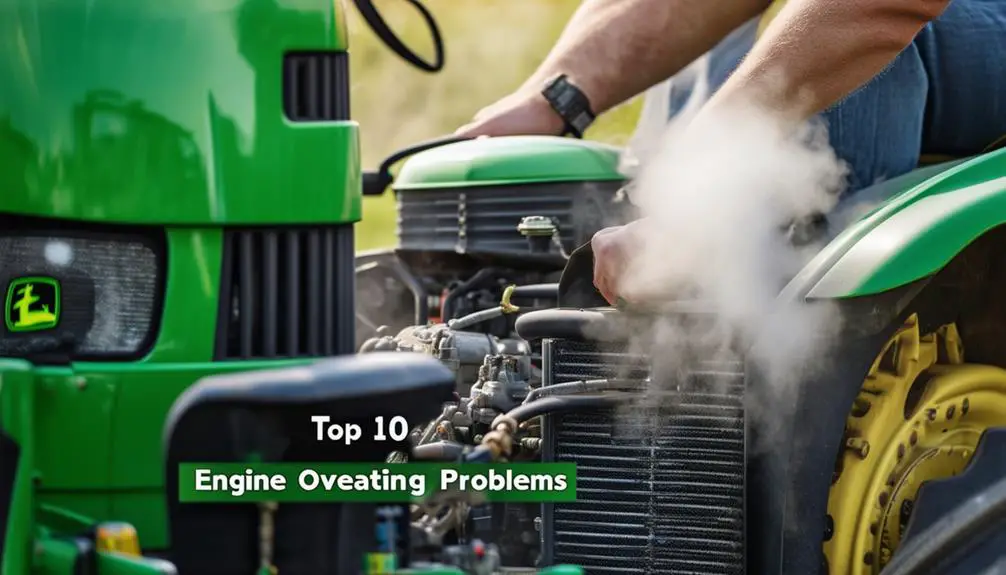
Are you facing frequent engine overheating problems with your John Deere 2210 tractor? If so, it's essential to address this issue promptly to ensure peak performance and prevent further harm.
One common reason for engine overheating in your John Deere 2210 could be a malfunctioning cooling system. Begin by checking the coolant levels and inspecting for any leaks in the radiator, hoses, or water pump.
Another aspect to ponder is the radiator fan. Verify that the fan is operating correctly and is efficiently cooling the engine during use.
Moreover, a blocked air filter or a soiled radiator could obstruct proper airflow, resulting in overheating problems. Regularly cleaning and replacing these parts can assist in maintaining the best engine temperature.
Do not overlook the warning signs of engine overheating, such as steam emanating from the hood or the temperature gauge rising sharply. By addressing these problems promptly and conducting regular upkeep, you can keep your John Deere 2210 operating smoothly and effectively.
Transmission Slipping
Experiencing transmission slipping in your John Deere 2210 tractor can indicate potential issues that require prompt attention to maintain peak performance.
Here are four reasons why your transmission might be slipping:
- Low Transmission Fluid Levels: Insufficient fluid can lead to inadequate lubrication and cause the transmission to slip.
- Worn Clutch: A worn-out clutch can struggle to engage properly, resulting in slipping when shifting gears.
- Faulty Transmission Solenoid: A malfunctioning solenoid can disrupt the flow of transmission fluid, leading to slipping.
- Clogged Filter: A clogged transmission filter can restrict the flow of fluid, causing the transmission to slip due to poor lubrication.
Addressing these issues promptly can help prevent further damage to your John Deere 2210 tractor's transmission. Remember, a smoothly operating transmission is key to keeping your tractor running efficiently and effectively.
Hydraulic Leaks
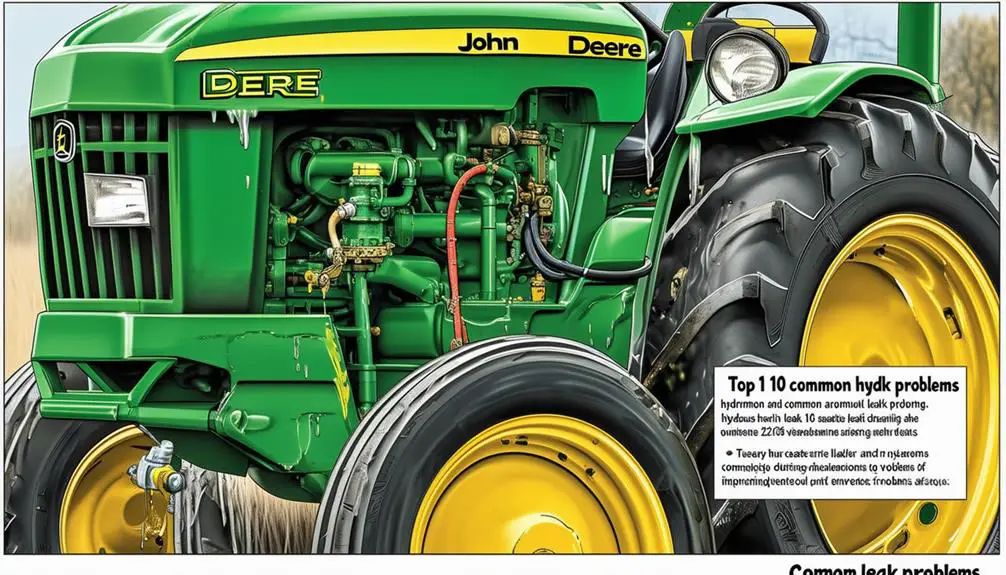
If you spot hydraulic leaks in your John Deere 2210, identifying the common leak locations is crucial. Understanding the reasons behind these leaks can assist you in addressing the issue effectively.
Stay tuned to learn about potential solutions to deal with hydraulic leaks on your tractor.
Common Leak Locations
Check the hydraulic connections, hoses, and fittings for visible signs of leaks on your John Deere 2210. It's essential to identify the common leak locations to prevent any issues from escalating. Here are some areas to pay attention to:
- Hydraulic Hose Connections:
Inspect where the hoses connect to the fittings. Look for any oil residue or wet spots that could indicate a leak. Tighten connections if needed.
- Cylinder Seals:
The seals on hydraulic cylinders can wear out over time, leading to leaks. Check around the cylinder rods for any signs of hydraulic fluid leaking.
- Hydraulic Pump:
Look at the pump for any oil seepage or drips. A leaking pump can affect the overall performance of your John Deere 2210.
- Valve Bodies:
Check the valve bodies for any signs of leaks. Leaking valves can result in loss of hydraulic pressure and efficiency. Tighten or replace valves as necessary.
Causes and Solutions
Identify potential causes of hydraulic leaks on your John Deere 2210 to effectively address and resolve the issues. Hydraulic leaks can be a nuisance, causing loss of fluid and decreased efficiency in your equipment. By understanding the common reasons behind these leaks, you can take proactive steps to prevent and fix them. Below is a table outlining some typical causes of hydraulic leaks on your John Deere 2210 and suggested solutions:
| Causes | Symptoms | Solutions |
|---|---|---|
| Worn out seals | Visible fluid leaks | Replace seals |
| Loose fittings | Oil puddles under the tractor | Tighten fittings |
| Damaged hoses | Sudden loss of hydraulic power | Replace hoses |
| Overheating components | Burning smell | Check fluid levels and cooling system |
| Corroded components | Rust around hydraulic connections | Clean or replace affected parts |
Electrical Failures
Common electrical failures in the John Deere 2210 include issues with the wiring harness and starter motor. When these problems arise, they can be frustrating and hinder your workflow. Here are some tips to help you troubleshoot and resolve electrical issues with your John Deere 2210:
- Check the wiring harness connections: Verify all connections are secure and free of corrosion. Loose connections can disrupt the flow of electricity and cause malfunctions.
- Inspect the fuses: Sometimes a blown fuse can be the culprit behind electrical failures. Check all the fuses in the electrical system and replace any that are damaged.
- Test the battery: A weak or dead battery can lead to electrical problems. Make sure the battery is fully charged and functioning properly.
- Examine the starter motor: If your John Deere 2210 is having trouble starting, the starter motor might be failing. Inspect it for any signs of wear and tear and replace if necessary.
Steering Alignment Issues
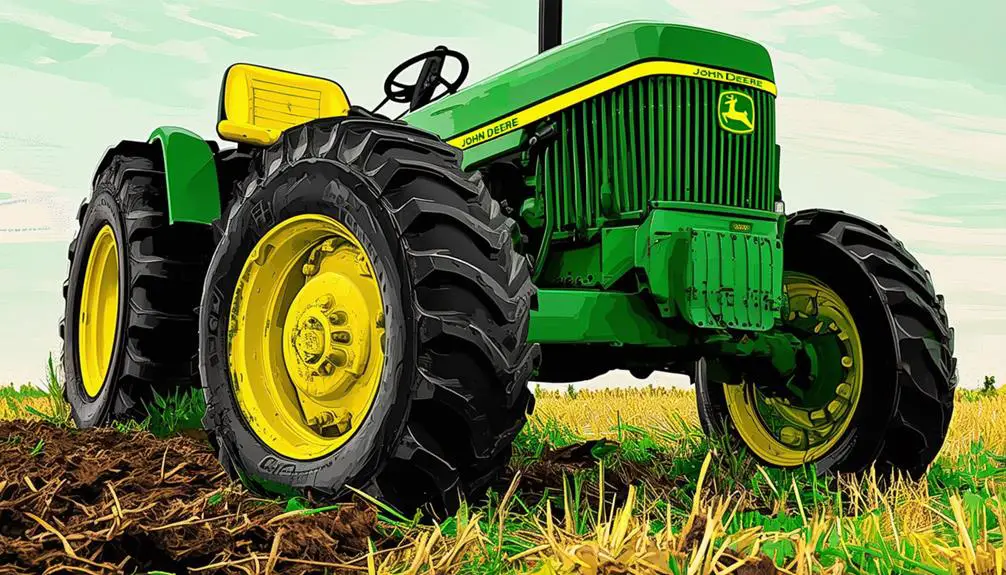
If you notice your John Deere 2210 veering to one side or experiencing difficulty in maintaining a straight path, you may be facing steering alignment issues. Steering alignment problems can arise due to various factors such as hitting obstacles, normal wear and tear, or improper adjustments.
To address this, start by checking the tire pressure and confirming that all tires are inflated to the correct levels. Next, inspect the tie rods, steering gear, and wheel bearings for any signs of damage or wear. Tighten loose components and make necessary adjustments to align the steering properly.
It's crucial to address steering alignment issues promptly to prevent further damage to your John Deere 2210 and ensure top-notch performance. Regularly inspecting and maintaining your tractor's steering system can help prevent alignment issues and keep your machine running smoothly during operation.
PTO Malfunction
You may encounter issues with your John Deere 2210's PTO system, such as difficulty engaging the PTO or problems with disengagement. These problems can affect the functionality of your equipment and may require troubleshooting to identify and resolve the underlying causes.
Stay alert to any irregularities in your PTO operation to prevent further complications while using your tractor.
PTO Engagement Issues
When experiencing PTO engagement issues with your John Deere 2210, it's important to address the malfunction promptly to avoid further damage. Here are some tips to help you troubleshoot and resolve the problem:
- Check PTO Switch:
Confirm that the PTO switch is in the correct position and functioning properly. Sometimes a simple adjustment or cleaning can solve the issue.
- Inspect Wiring:
Examine the wiring connected to the PTO for any signs of wear, damage, or loose connections. Faulty wiring can prevent the PTO from engaging correctly.
- Verify Safety Features:
Make sure all safety features, such as seat sensors or brake interlocks, are working correctly. If these features aren't engaged properly, it can prevent the PTO from activating.
- Consult Manual:
Refer to the John Deere 2210 manual for specific troubleshooting steps and maintenance tips related to PTO engagement problems. The manual can provide valuable insights into resolving the issue efficiently.
PTO Disengagement Problems
To address PTO disengagement issues (PTO malfunction) with your John Deere 2210, it's important to investigate potential causes and take corrective action promptly. When your PTO fails to disengage, it can lead to safety hazards and equipment damage.
Begin by checking for any obstructions or debris around the PTO shaft that may be preventing proper disengagement. Inspect the PTO clutch for wear and tear, as this could be a common culprit. Additionally, make sure that the PTO linkage is properly adjusted and lubricated to allow for smooth disengagement.
If these initial checks don't resolve the issue, it may be necessary to dig deeper into the PTO system. Faulty wiring or a malfunctioning PTO switch could also be causing the disengagement issues. In such cases, consulting a professional technician or referencing the John Deere 2210 manual for troubleshooting guidance is recommended to address the issue effectively.
Fuel System Problems
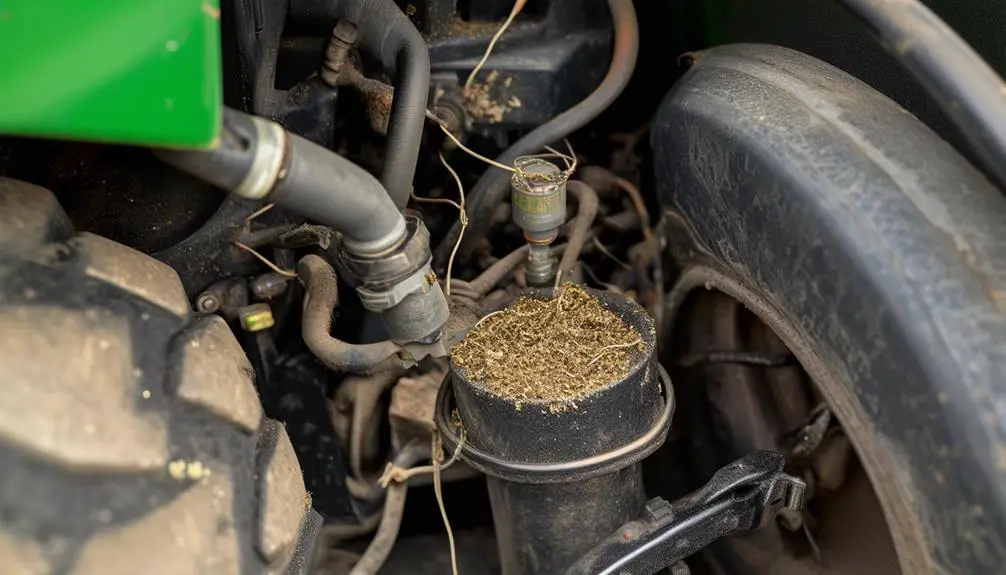
If experiencing issues with the fuel system on your John Deere 2210, it's crucial to address them promptly to prevent further damage. Here are some common fuel system problems you might encounter and how to tackle them:
- Clogged Fuel Filter:
A clogged fuel filter can restrict fuel flow, leading to engine stalling or poor performance. Replace the fuel filter regularly to ensure proper fuel delivery.
- Dirty Fuel Injectors:
Dirty fuel injectors can cause rough idling, decreased power, and increased fuel consumption. Consider cleaning or replacing the injectors to restore peak engine performance.
- Fuel Contamination:
Contaminants like water or debris in the fuel can harm the engine. Drain the fuel tank, flush the system, and refill with clean fuel to prevent damage.
- Faulty Fuel Pump:
A failing fuel pump can result in low fuel pressure, causing starting issues or engine hesitation. Check the fuel pump for any malfunctions and replace if necessary to maintain smooth operation.
Cooling System Troubles
Dealing with cooling system issues on your John Deere 2210 can lead to overheating and possible engine damage if left unattended. To prevent these issues, make sure to regularly check the coolant levels and inspect for any leaks in the system. If you notice your tractor overheating or the temperature gauge rising quickly, it's essential to address the problem immediately.
One common cooling system issue is a faulty thermostat, which can cause irregular temperature regulation. Another problem could be a clogged radiator that prevents proper heat dissipation. Keeping your radiator clean and free of debris is necessary for optimal cooling system performance.
If you experience cooling system issues, don't ignore them. Ignoring warning signs can result in costly repairs or even engine failure. Stay proactive and attentive to your John Deere 2210's cooling system to avoid potential setbacks and optimize your tractor's longevity.
Tire Wear and Tear
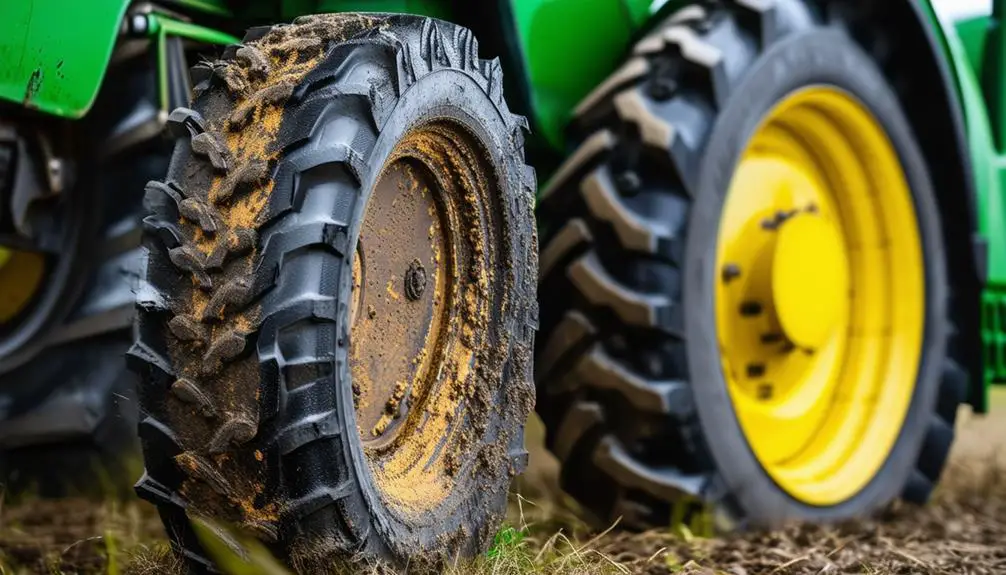
You might notice uneven tire pressure, which can lead to premature wear and affect your John Deere 2210's performance.
Alignment issues may cause your tires to wear unevenly, impacting stability and handling.
Keep an eye out for worn tread patterns, as they can compromise traction and safety while operating your equipment.
Uneven Tire Pressure
Uneven tire pressure on your John Deere 2210 can lead to accelerated tire wear and tear, affecting the overall performance of your equipment. Keeping an eye on your tire pressure is vital to guarantee that your John Deere 2210 operates at its peak.
Here are some key points to ponder:
- Regular Inspections: Make it a habit to check your tire pressure frequently to catch any discrepancies early on.
- Proper Inflation: Ensure that your tires are inflated to the recommended pressure levels to prevent uneven wear.
- Equalize Pressure: Check that all tires have the same pressure to maintain stability and prevent one tire from wearing out faster than others.
- Adjust for Conditions: Remember to adjust tire pressure based on the terrain and work conditions to optimize performance and longevity.
Alignment Issues
Maintaining proper alignment on your John Deere 2210 is essential to prevent excessive tire wear and tear, ensuring peak performance. Misaligned wheels can cause your tires to wear unevenly, leading to premature deterioration and decreased efficiency.
When alignment is off, your tires may exhibit signs such as feathering, where the tread wears unevenly in a sawtooth pattern, or camber wear, where the inside or outside of the tire tread wears more rapidly. These issues not only compromise the traction and handling of your tractor but also increase the risk of blowouts and other tire-related problems.
To avoid alignment issues, regularly inspect your tires for signs of uneven wear and have a professional technician adjust the alignment as needed. By addressing alignment problems promptly, you can extend the lifespan of your tires, improve fuel efficiency, and maintain peak performance from your John Deere 2210.
Worn Tread Patterns
Inspect your John Deere 2210's tires regularly to identify worn tread patterns indicative of tire wear and tear issues. These patterns can give you important clues about your tractor's overall health and help you address problems before they escalate.
Here are some common worn tread patterns to look out for:
- Feathering: If one side of the tread blocks is more worn than the other, it could indicate misalignment or improper tire inflation.
- Center Wear: Excessive wear in the center of the tire suggests overinflation, leading to reduced traction and a rougher ride.
- Outer Edge Wear: Wear on the outer edges may signal underinflation or excessive cornering, impacting stability and handling.
- Cupping: Irregular dips or cups forming on the tread could be due to worn shocks or struts, causing vibrations and noise during operation.
Brake System Failures
Regularly inspect your John Deere 2210 for any signs of brake system failures to ensure safe operation. Your safety is paramount when operating heavy machinery like the John Deere 2210, and ensuring the brakes are in best condition is essential.
Brake system failures can pose serious risks, compromising your ability to stop the equipment efficiently and potentially leading to accidents. Watch out for warning signs such as unusual noises when applying the brakes, reduced braking power, or a soft brake pedal. These indicators could signal issues like worn brake pads, air in the brake lines, or brake fluid leaks that need immediate attention.
Ignoring brake problems can result in costly repairs, downtime, and, most importantly, safety hazards. By staying vigilant and addressing any brake system failures promptly, you can maintain a safe working environment and prevent accidents while using your John Deere 2210.
Frequently Asked Questions
How Can I Prevent Common John Deere 2210 Problems?
To prevent common John Deere 2210 problems, stay on top of maintenance tasks like regular oil changes and filter replacements. Keep an eye on wear and tear, addressing any issues promptly.
Follow the manufacturer's guidelines for operation and storage. Regularly inspect your equipment for signs of trouble, and don't ignore any strange noises or performance issues.
Are There Any Warranty Options for These Issues?
If you're wondering about warranty options for those issues, you'll be pleased to know that some problems with the John Deere 2210 may be covered by warranty. Always check with your dealer or manufacturer to see if your specific concerns are eligible for coverage.
This can provide peace of mind and potentially save you money on repairs. Don't hesitate to inquire and protect your investment.
Can I Use Aftermarket Parts to Fix These Problems?
You can definitely use aftermarket parts to fix these problems. They can be a cost-effective solution and provide alternatives to the original parts.
Make sure to do your research and choose reputable brands to guarantee quality and compatibility. Some aftermarket parts may even offer improved performance compared to stock parts.
Just be cautious and verify that the parts meet the necessary specifications for your John Deere 2210.
Are There Any Software Updates Available for the John Deere 2210?
Yes, there are software updates available for the John Deere 2210. Updating the software can enhance performance, fix bugs, and add new features.
It's recommended to regularly check for updates to guarantee your equipment is running smoothly. Don't hesitate to reach out to your local dealer or visit the official John Deere website for more information on how to get the latest software updates for your 2210.
What Maintenance Schedule Should I Follow to Avoid These Issues?
To avoid potential problems with your John Deere 2210, stick to a regular maintenance schedule. It's crucial to change the oil and filters as recommended by the manufacturer.
Keep an eye on tire pressure, lubricate moving parts, and inspect belts and hoses for wear. Following these maintenance tasks can help prevent issues and keep your equipment running smoothly.
Conclusion
Now that you know the top 10 John Deere 2210 problems, it's time to take action. Don't let engine overheating or transmission slipping slow you down.
Address hydraulic leaks and electrical failures promptly. Keep an eye on steering alignment and fuel system maintenance.
Don't overlook cooling system troubles, tire wear, or brake system failures. Stay on top of these issues to keep your John Deere 2210 running smoothly and efficiently.